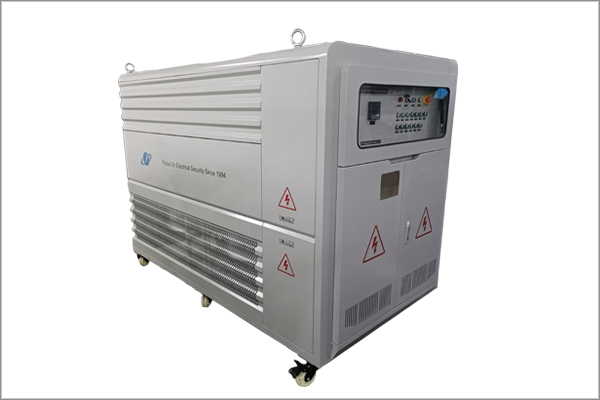Load Bank: The Central Hub for Ensuring Stable Power System Operation and Equipment Optimization
Time:2025-05-10
In modern society, electricity, like blood, sustains the operation of cities. From the bright lights of high-rise buildings to the precise computing in data centers, the stable operation of the power system is of vital importance. In this vast and complex power system, the load bank, as a little-known yet indispensable core hub, is quietly playing a crucial role. It is not only the "stabilizing anchor" ensuring the stable operation of the power system, but also the "unsung hero" promoting the optimization and upgrading of power equipment.
The load bank is essentially a simulated electrical equipment that provides various load conditions for the power system and equipment by absorbing and consuming electrical energy. It is like an adjustable "virtual electricity world", capable of precisely simulating various electricity usage states ranging from low load to full load and even overload. Its working principle is based on the conversion and consumption characteristics of electrical energy by components such as resistors, inductors, and capacitors. By controlling the combination and parameter adjustment of these components, it realizes the simulation of different types of loads. For example, resistive load boxes can simulate pure resistive devices such as incandescent lamps and electric furnaces, converting electrical energy into thermal energy. Inductive load banks are used to simulate the inductive characteristics of equipment such as motors and transformers. Capacitive load banks can simulate capacitive devices such as compensating capacitors.
In terms of the stable operation of the power system, the role of the load bank is irreplaceable. In the power generation process, whether it is thermal power generation, hydropower generation or new energy power generation, load tests are required during the start-up, shutdown and operation of the power generation units. The load bank can simulate different power demands, assisting the generator set in commissioning and performance testing under various working conditions. By connecting to the load bank, technicians can observe the changes in parameters such as output voltage, frequency and power of the generator set under different loads, and adjust the operating state of the unit in a timely manner to ensure that it can stably output electrical energy that meets the standards. In the power transmission and distribution process, equipment such as substations and distribution systems also need to undergo load testing. The load bank can simulate the actual power load, helping to detect the carrying capacity and operational stability of power transmission equipment, identify potential safety hazards in advance, and ensure the reliable transmission of electricity.
In addition to ensuring the stable operation of the power system, the load bank is also an important tool for the optimization and upgrading of power equipment. During the equipment research and development stage, engineers use load banks to simulate various complex power consumption environments and conduct strict performance tests and optimizations on power equipment. Take the charging piles of new energy vehicles as an example. During the research and development process, the charging demands of different types of electric vehicles are simulated through load banks to test the output characteristics, charging efficiency and safety of the charging piles under various working conditions. Thus, the design and control strategies of the charging piles are optimized to improve their performance and compatibility. In terms of equipment maintenance and repair, the load bank also plays an important role. By connecting the operating power equipment to the load bank for testing, the health status of the equipment can be accurately evaluated, whether there are potential faults in the equipment can be determined, providing a scientific basis for equipment maintenance and repair, and extending the service life of the equipment.
With the continuous development of power technology and the advent of the intelligent era, load banks are also constantly being upgraded and iterated. Intelligent load banks are gradually becoming the mainstream in the market. They integrate advanced sensors, communication modules and control algorithms, and can achieve functions such as automatic load regulation, real-time data monitoring and remote control. These intelligent features not only enhance the testing accuracy and efficiency of the load bank, but also provide strong support for the intelligent management and optimization of the power system. For instance, in a smart grid, intelligent load banks can automatically adjust the load size based on the real-time operating status of the grid, achieving dynamic balance regulation of grid power and enhancing the stability and reliability of the grid.
The load bank, as the core hub for the stable operation of the power system and equipment optimization, plays an increasingly important role in the modern power field. From ensuring the stable operation of the power system to promoting the optimization and upgrading of power equipment, and from traditional manual control to intelligent automatic regulation, every technological advancement of load banks is injecting new impetus into the development of the power industry. In the future, with the continuous innovation of power technology and the constant growth of application demands, load banks will surely contribute more to the construction of a modern power system that is safe, stable and efficient with more advanced technologies and smarter functions.
News Recommendation
-
 2024-09-11
2024-09-11TRIUMPH LOAD EXHIBITING AT Enlit Europe 2024 -BOOTH 7.H08
-
 2023-04-21
2023-04-21TRIUMPH LOAD EXHIBITING AT DATA CENTER WORLD GERMANY 2023-BOOTH F909
-
 2023-04-06
2023-04-06TRIUMPH LOAD EXHIBITING AT ELECTRIC POWER TECH KOREA 2023 – Booth G109
-
 2022-05-05
2022-05-05What is the role of ac load bank for power supply?
-
 2022-05-05
2022-05-05What is the role of the load bank?


